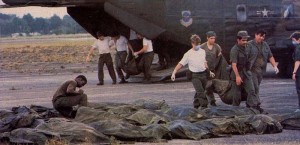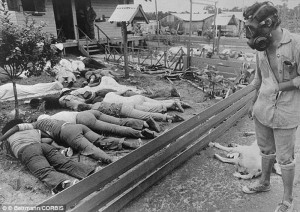Latest update April 3rd, 2025 7:45 PM
Jonestown remembered
Nov 18, 2015 News
Today marks the 37th anniversary of the world’s biggest mass suicide, which occurred at Jonestown in Guyana’s North West District.
On November 18 1978, a drug-crazed American evangelist, Jim Jones, led hundreds of his followers whom he had brought from California, to their deaths.
The incident gave Guyana infamous world notice and today, after a few movies and several documentaries, it is still a hot topic whenever the anniversary comes around.
To mark the occasion Kaieteur News is reprinting extracts from an Associated Press article that was first published in December 2008
The Legacy of Jonestown
By Eric Banks
We expect our killing fields to be marked a certain way, and with at least a certain rhetoric of rectitude. At Jonestown, in Guyana, there are no markers, no memorials noting what took place, no manicured clearings to mark
how the site looked 30 years ago, when more than 900 Americans died there in a still hard-to-imagine moment of mass suicide and outright murder. It is an open field bifurcated by a red dirt road, with knee-high bush to the north and, to the south, thick jungle. You don’t even realize you have entered the site until you are already there.
The wooden billboard that used to hang over the entry, proclaiming “Welcome to Jonestown / Peoples Temple Agricultural Project,” vanished long ago, along with virtually all other signs of Jim Jones and his followers, who died by the lethal ingestion of cyanide-spiked grape Fla-Vor-Aid, forced injection and gunfire. It is as though the memory of the massive loss of life — following the brazen murder of a U.S. Congressman who had come to investigate complaints about the compound, three members of the media accompanying him and a commune defector at a nearby airstrip — is still too extreme to be remembered.
The event remains the most famous moment in the history of Guyana, which is roughly the size of Kansas and is the lone English-speaking country on the South American continent. The memory of the massacre is spooked with dark ironies about the country’s history of independence from Great Britain. The Guyanese government had tried to develop a new and proud independent identity for the country that would serve as a model for postcolonial development — and initially welcomed Jim Jones as a blow to the American forces of imperialism. After the massacre, the country’s leaders opted to absolve themselves of the events, pointing to the Americans as if they had landed from Mars.
Today, it isn’t much easier to mourn and memorialize the victims when doing so is an admission of the country’s failed hopes. Marking the tragedy has been no less acute in the U.S. It was only during the 30th anniversary of the deaths, that a marker was erected at a cemetery in Oakland, Calif., to memorialize the 410 Jonestown victims buried there, 60 of them unclaimed.
The Jonestown site lies far in the bush, an hour’s flight by charter plane from the sleepy coastal capital of Georgetown and another half-hour drive down a bumpy road.
“Do you know the bush?” asked my guide there, a slightly built, soft-spoken man from the nearby town of Port Kaituma named Carlton Daniels, as we entered the site of the former compound on the back of his son-in-law’s pick-up. The question wasn’t meant as a conversation starter: A vine he called a “let-me-go” dangled overhead. “It will grab on to you,” he warned.
Mr. Daniels, a semi-retired contractor, is the unlikely Virgil of Jonestown; he has lived in the area all his life and had been postmaster in the 1970s, when he first met the handful of Californian pioneers from the People’s Temple. They began to show up around 1974 after the organization leased 25,000 acres from the Guyanese government. (The bulk of the congregants, an unlikely cohort of African-American seniors, youthful white progressives and a small army of school-age children, would arrive two years later as unflattering reports of financial irregularities and church beatings began to appear in the San Francisco media.) Wading through the knee-high growth, he pointed out what was once a grove of cashew and lime trees, which marked the area around Mr. Jones’s cabin and now struggled to survive against flora more suited to the blazing, nearly equatorial sun.
Mr. Daniels recalled being let in the compound by the Guyanese Defence Force three days after the massacre to retrieve some fuel containers he had lent to the People’s Temple. “I didn’t want to come back here for a long time after that,” he whispered, as if he were worried he might be overheard.
Trailing his son, who was armed with a cutlass against the jungle and the notoriously deadly bushmaster snake, we searched in vain for the remains of Mr. Jones’s piano, its rotting keyboard having been turned up by a party including the Minister of Tourism a year earlier. We had no more luck in finding any traces of the cage that once held Mr. Muggs, the pet chimpanzee Mr. Jones adopted, who perished alongside the 913 humans.
“They should have done something to keep the area the way it was,” Mr. Daniels said as his son emerged from a path-clearing reconnaissance job, his upper torso pock-marked with fresh bee stings. Mr. Daniels didn’t elaborate on the thought, but he didn’t need to. He admired the achievement of establishing a commune in such an inhospitable environment and recounted the lovely grove of well-tended fruit trees that once lined the entry. We followed his son about 40 yards into the bush and located the pits where recalcitrant children were kept as punishment (almost a third of the Jonestown victims were kids). Further along, we found what was left of Jonestown: a couple of vehicles turned on their sides; a flatbed truck with a skinny sapling growing through its chassis; and a long metal container that looked like it was once a refrigerator.
Over time there have been intermittent schemes to clear and memorialize the site.
No political leader was more adept at exploiting the idea or realizing its failure than Forbes Burnham, who led the country from independence in 1966 until his death in 1985. His aspirations to create a unique Guyanese path to socialism — through a top-heavy program of massively nationalized industry and agriculture in the interior — aggressively chased off foreign investment.
Mr. Burnham welcomed not only Jim Jones but other soi-disant radical movements into Guyana, turning the country into an ideological Disneyworld for the charismatic and the disaffected in the late ’70s.
In 1978, Mr. Burnham’s unpopularity was growing and his overconfident austerity economy was failing. Guyanese-style socialist development meant not only nationalization of foreign companies but strict laws against exports, which led to crippling food shortages. The local Georgetown newspapers at the time had many more headlines on garlic and onion smuggling than the murder-suicides at Jonestown.
“When it happened, a lot of us wanted to preserve the site,” Georgetown mayor Hamilton Green says, “but it was impossible.” Mr. Green had been a ranking government official when Mr. Burnham ran the country. “Burnham just said no.” Mr. Green’s wife, Shirley Field-Ridley, who died in 1982, was minister of information in the Burnham cabinet, and as the evening of Nov. 18 unfolded, the country was overwhelmed by what had taken place.
“We heard the death toll go from 10, to 100, to 300. What could we do? We only had 30 body bags in the whole country,” Mr. Green says. Like others in Georgetown, he darkly hinted of CIA involvement in Jonestown. There were rumors.
Most of the Guyanese officials who were in power in the 1970s are dead, and questions as to how Mr. Jones’ sect flourished mostly unhindered in the jungle are simply impossible to answer. Mr. Burnham died in 1985; his agriculture minister Dr. Ptolemy Reid, whose portfolio brought him into the most direct contact with Mr. Jones, died in 2004.
The point of departure from Port Kaituma to Georgetown is the same little-used dirt airstrip where Rep. Ryan and his entourage came under the fatal fire of the Jonestown killer who pursued them in a small flatbed trailer. There, one signs in with a Guyanese Defence Force official on arrival and departure (drug smuggling into and out across the nearby Venezuelan border remains a fear).
In anticipation of a tiny charter plane’s landing, cows were shooed from the runway. A man named Troy came over to sit next to the Guyanese army officer, and began to cite scripture to explain why the spirits of Jonestown remained behind to haunt the land. Mr. Jones, he said, had attempted to make himself God over his kingdom. He quoted Colossians 2: “and having spoiled principalities and powers, he made a shew of them openly, triumphing over them in it.”
From the plane above it’s nearly impossible to make out the Jonestown site from the sky. All that is visible is a ruffled ground of green interrupted occasionally by smoke and, here and there, by a lonely homestead. It remains that way for most of the hour-long flight, until the jungle abruptly comes to an end and the neatly ordered checkerboard squares of the coastal cane fields comes into view.
Share this:
- Click to print (Opens in new window)
- Click to email a link to a friend (Opens in new window)
- Click to share on Facebook (Opens in new window)
- Click to share on WhatsApp (Opens in new window)
- Click to share on Twitter (Opens in new window)
- Click to share on Pinterest (Opens in new window)
- Click to share on Pocket (Opens in new window)
- Click to share on Tumblr (Opens in new window)
- Click to share on Reddit (Opens in new window)
- Click to share on LinkedIn (Opens in new window)
Related
Similar Articles

The Glenn Lall Show|| March, 31st, 2025
Follow on Tik Tok @Glennlall
THE BLUNT OF THE DAY

Sports
Apr 03, 2025
Kaieteur Sports- When the competition continued there were action at the Rose Hall Community Centre in East Canje and the Berbice High School Grounds. There were wins for Berbice Educational...Features/Columnists
A coalition of shared disgrace
Peeping Tom… Kaieteur News- The APNU and the AFC deserve each other. They deserve to be shackled together in a coalition... more
The U.S. “Joining” the Commonwealth: an unreasonable expectation
By Sir Ronald Sanders Kaieteur News- Recent media stories have suggested that King Charles III could “invite” the United... more
Publisher’s Note
Freedom of speech is our core value at Kaieteur News. If the letter/e-mail you sent was not published, and you believe that its contents were not libellous, let us know, please contact us by phone or email.
Feel free to send us your comments and/or criticisms.
Contact: 624-6456; 225-8452; 225-8458; 225-8463; 225-8465; 225-8473 or 225-8491.
Or by Email: [email protected] / [email protected]
Weekend Cartoon

















